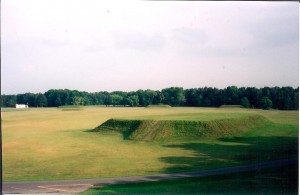We woke in Demopolis, and once we showered and breakfasted, we explored the area. Our first stop was White Bluff, a historic site along the Tombigbee River. Along with the beautiful landscape, we sampled the locally preserved remains of Southern history: slave quarters, antebellum architecture, Rupert standing guard over his fallen confederates. These elements had become routine by day 6.
It was Sunday, and almost everything was closed, so we headed up the road. Along the highway, we encountered something not routine: Jim Bird’s Hay Bale Art display. For the aesthetic pleasure of his neighbors and travelers, Mr. Bird has been erecting sculptures made of hay bales and discarded farm equipment on his land. This was a delight to find, as the bales display whimsy as well as ingenuity. We stopped on the road to gawk shamelessly. I have an embarrassing number of photos of this, but will share just a few.
Next, we headed to Tuscaloosa, home to the University of Alabama. We wandered around the campus, admiring the stately fraternity and sorority houses and comparing our own experiences as undergraduates.
At this point, we had worked up a considerable appetite. Our guide books recommended an Italian restaurant, so we spent a leisurely lunch there. Because much of the world was closed that Sunday, we had time to relax over a meal. We even found ice cream cones at a local mall, and sat out in the sun enjoying them, the first time we had been able to have a sunny afternoon ice cream since we arrived in Alabama.
From there, we went back into Tuscaloosa to find a glass pane that was described in our guide books. Apparently, at the courthouse, an African-American man’s face was etched into the glass when lightning struck as a crowd gathered outside to lynch him. The guide books go on to relate that the man, Henry Wells, died that day. It was difficult to know if it was in the lightning or the lynching. We drove around Tuscaloosa in an effort to find the etched window, but could not even find the Courthouse, a structure that is generally prominent in Alabama towns. The search provided an opportunity to explore the town, even if our legend hunting proved fruitless. The day had not been wholly unproductive for us as folklorists; we had encountered the fabulous folk art of Jim Bird, if not the face of Henry Wells. (nb: according to what I can find on Google nearly 12 years later, the Henry Wells incident happened at the Pickens County courthouse, not in Tuscaloosa. For more information, see the link above).
Finally, late in the afternoon, we gave up and headed for Indian mounds in Moundville. Once again, it was good to experience some history beyond slavery, the Confederacy, and Civil Rights. Because it was Sunday, there was nobody at the mounds, and it was a gorgeous day, we climbed up the biggest one.
The we continued in our sleepy Sunday way toward Cullman, where we had reservations for the night. It was a pretty drive, full of trees, and we used the time to check in with family by cell phone and talk about life beyond our travel plans. We had decided to skirt Birmingham at this point in the trip; our preference for small towns and their attractions becoming clearer with each day, as was our sense of familiarity with the place and its past. Somehow, Alabama had worked its charm on us, and without knowing it, we had stopped feeling lost in a strange place. We received a warm welcome at the Days Inn in Cullman, and sat up watching Jimmy Carter on the television as he discussed his new book on growing up in the divided South we were wandering in.











